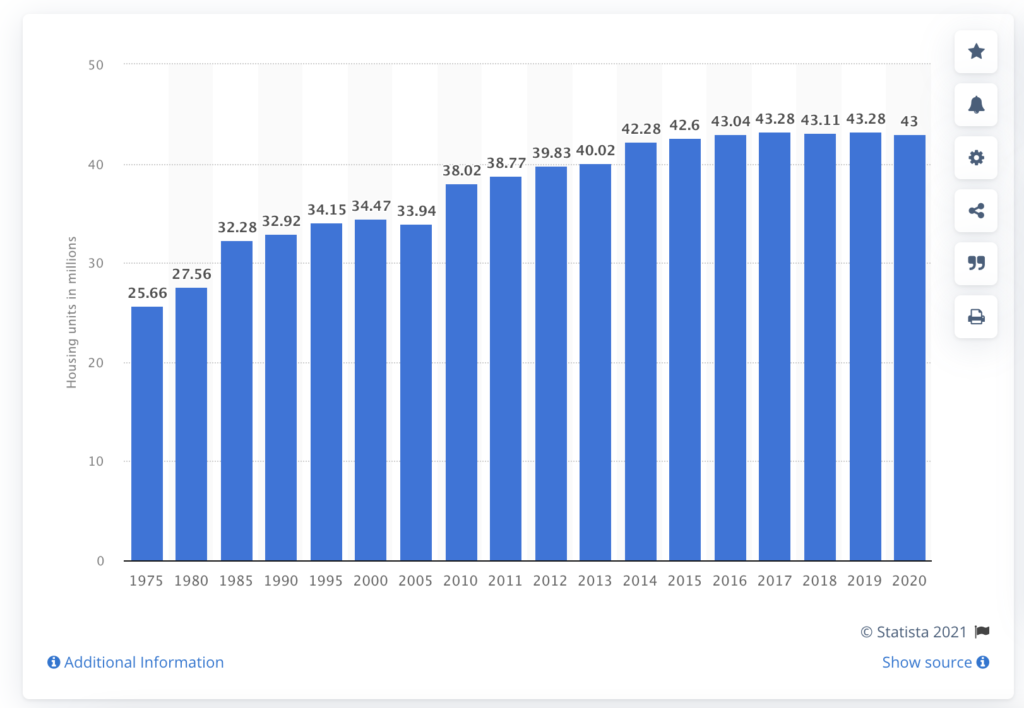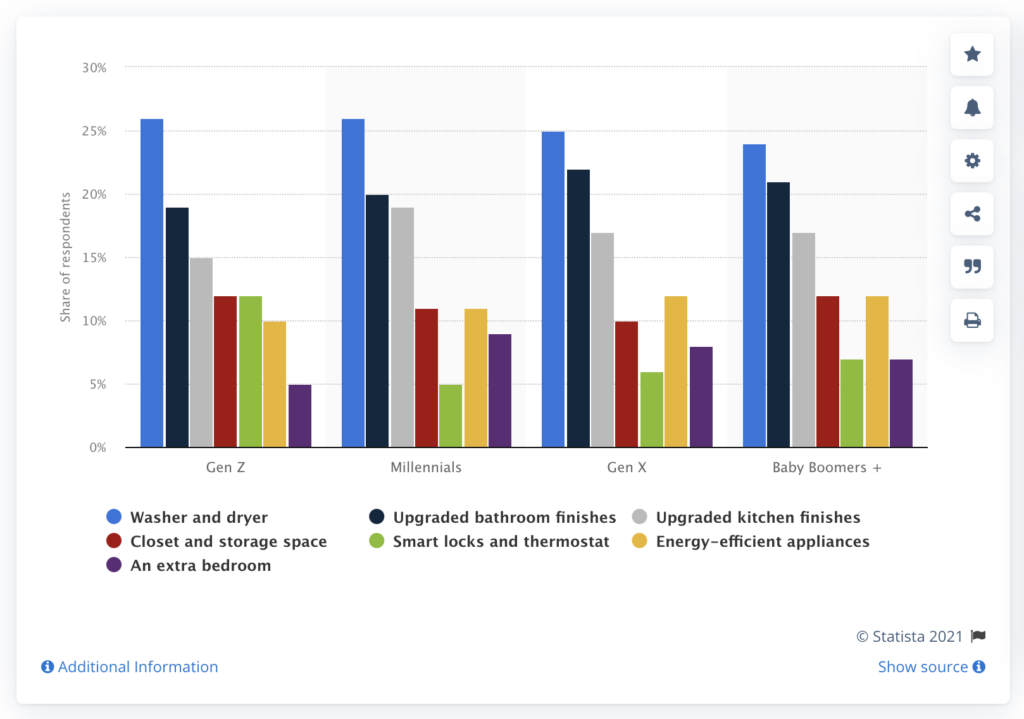Investors always need to look towards the future, especially in multi-family housing real estate. By looking forward, you can find opportunities for growth and gauge the potential of a chosen project. In the multi-family housing industry, you’ll get the best sense of the future of the industry by assessing the current generational trends.
From Gen Z to Boomers, generational trends are changing the landscape of the multi-family housing industry. According to Statista, in recent years the United States rental market has seen an increase in demand for apartment and house rentals across all age groups.
And In 2020, there were approximately 43 million housing units occupied by renters in the United States. This number has remained steady since 2014 but is part of a long-term upward swing since 1975.

This trend is expected to continue into the coming years, with a full rebound from the impact of the pandemic by 2022. To get a better idea of the current state of the multi-family housing industry and how future generations are making waves, keep reading.
In this article we’ll explore:
- Exploring Generational Trends of Each Group
- The Appeal of Multi-Family Housing
- Why Multi-Family Housing is an Investment for Years to Come
Exploring Generational Trends
There is a distinct difference in how the generations view their multi-family housing options. Understanding these generation trends can help investors see the opportunities for development and acquisition going forward.
Let’s break down the current generation view of multi-family housing options.
Generation Z
Gen-Z, the youngest generation, is also the newest generation to begin considering multi-family housing options. Classified as being born between 1997 to 2012 with the oldest of the bunch now graduating from college and looking to venture out on their own.
While there is not much data on the newest renters to explore the market, there are many indicators of how the trends of their generation, and many others, will affect multi-family housing for years to come.
Millennials
Next up are the Millennials (1981 and 1996). Millennial-age renters drive the bulk of demand for multi-family housing. In 2020, over 18% of millennial renters say they plan to rent forever, up for the third consecutive year from 12.3% in 2019 and 10.7% in 2018. And, whether in urban cores or the suburbs, millennials prefer a sense of convenience and a lot of outdoor space in their multi-family living.
Generation X
Gen-X is a generation often overlooked when looking at multi-family rental investments. This is primarily because Gen-X (1965-1980) are mostly homeowners, right now. This shouldn’t exclude them from the multi-family housing investor consideration. With their Gen-Z children moving out, Gen-X are considering multi-family housing options for downsizing as they head into retirement.
Baby Boomers
Finally, it’s Baby Boomers (1946 to 1964). As this generation ages,multi-family housing options geared toward active aging and community living is top of mind for their retirement years. And according to research, renter households aged 60 and over, drove the past decade’s surge in seniors renting, with a 43% increase! Like Millennials, they desire convenience. Unique to older renters though, is a feeling of community. Learn more about our commitment to Senior Living.
The Appeal of Multi-Family Housing by Generation

Although there are many similarities between the generations, there are still a few important differences to take note of. Let’s take a closer look at the wants and needs each generation is seeking in multi-family housing.
Gen Z Desires Tech-Savvy & Socially Conscious
Renter-ready Gen-Zers have grown up in a world filled with technology. Often called the instant generation, the oldest members of Gen-Z require ease at the tip of their fingers. 20% of Gen Z renters (and 17% of millennials) rate smart home capabilities as very important according to Zillow.
They aren’t just hopeful for tech-friendly rentals, they’ve come to expect them. Appropriate amenities include:
- Online rent payment options
- Responsive email communication
- USB ports
- Smart locks
- And, of course, fast Wi-Fi
And while you could say technology is perhaps their most important draw, they are also mindful of their carbon footprint. Renters in this age group are socially conscious. 21% of Gen Z renters prioritized rooftop decks or gardens in multi-family housing. So lots of green space and options for recycling will also be on their radar when it comes to multi-family housing.
Millennials Seeking Space & Balance in Work & in Life
Millennials are second in numbers only to Generation Z. But because of their age, their amenity preferences can (and do) have a lasting effect on the multi-family industry.
Like Gen-Z, they care quite a bit about technology. They’ll want all of the amenities listed above and perhaps more. With COVID-19 forcing a shift to remote work, many millennials are now opting to work from home if they weren’t already doing so. What this means in terms of housing is put simply: more space.
Whether they’re looking for a dedicated room to use as an office or are interested in expanding their family, Millennials are seeking larger layouts with more space for the things they love.
In addition, health and wellness is another way to win over this generation. Fitness features — inside and out are at the top of the amenities list for Millennials.
Gen-X Look for Luxury & Location
For a generation hit hard by the housing crash, but still rooted in valuing their homeownership, Gen-Xers who are moving to multi-family housing have high demands. They seek luxury features like granite countertops, new cabinets, lots of windows, large closets, and more.
Additionally, they want to be in locations where they can easily and safely walk to local restaurants, parks, and shopping. Pools, cabanas, and fitness facilities also make their list of requirements for multi-family housing.
Convincing Gen-X to consider multi-family housing means investors need to deliver resort-style living in centralized, walkable locations.
Baby Boomers Want Relaxation & Community Relations
The final generation, Baby Boomers, are typically looking for convenience and community. Baby Boomers have likely already owned a home and tend to fall into one (or more) of the following categories:
- Empty-nesters downsizing after their children leave home
- Active adults in search of a more vibrant community
- Couples seeking a more cost-effective home solution
- Retirees dreaming of a fresh start
They may not be the biggest generations anymore, however, Baby Boomers still have buying power and the ability to alter the landscape of the industry. Boomers want the ease of calling a property manager for home maintenance tasks. They seek community living with like-minded adults.
Let’s not ignore the importance of having options for their health as they age. From active living, independent communities with fitness facilities and activities, Baby Boomers are thinking about what happens when they need more care.
An Investment for Years to Come
As you can see, multi-family housing is a great option for anyone who wants flexibility or convenience when it comes to their living spaces — regardless of age.
The market is ripe with opportunities for growth. And, based on the current data, if we were to hinge the future of the industry on future generations? The future of multi-family investment is definitely looking bright!
If you’re an investor interested in learning more about this industry and the opportunities for development within it, contact us today.
Our team has a deep background in multi-family housing development and acquisitions. We apply our extensive market research, site selection process, and asset management expertise to every project for optimal returns.


